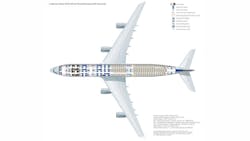A general aviation airport in Cartersville, Georgia, is home to Phoenix Air, the most recognized jet-charter air service in the world as of late. It unofficial motto has always been: “The biggest company you’ve never heard of.”
That all changed in the summer of 2014. Dent Thompson, vice president and COO of Phoenix Air, was reading the morning newspaper while on vacation in the North Carolina mountains when his cell phone rang. The voice on the other end was the Chief of Emergency Medicine for the United States State Department.
“You know that device you developed for your plane?” he asked Thompson.
“Yes, the Aeromedical Biological Containment System (ABCS)?”
“Does it work? Where is it? Have you ever used it?”
Then, the question Thompson knew was coming: “How about Ebola?”
“Ebola?” Thompson asked.
“Yup. Ebola.”
“You’re asking us to go from the high school basketball court straight to the NBA,” Thompson recalls was his response. “How serious is the government?”
“Very serious.”
A couple days after the top doctors in the country flew into Cartersville, set up the unit in Phoenix Air's specially designed Gulfstream III, analyzed it and gave it a passing grade.
“Forty-eight hours later the ABCS was in our jet and we were headed to Liberia to bring home Dr. Kent Brantly” Thompson says. “We then turned around to get Nancy Writebol."
A small town success story
Thirteen other Ebola-infected patients have also been brought out of Africa by Phoenix Air, three of them Americans: Ashoka Mukpo, Nina Pham and Amber Vinson. But long before the name Phoenix Air was associated with the Ebola epidemic, Thompson's brother Mark made the decision to open a business in their hometown of Atlanta that would be unique to air services.
Thompson left The Walt Disney Company in 1984, after writing in its offices for 13 years and joined Mark, who had retired from the army. "The rest is history," he says.
The brothers relocated their business to a smaller county location, Cartersville Bartow Airport (KVPC), in 1985 with just two Learjet 24 models, a Piper Navajo, and an older Beechcraft 18. The company also has offices in Florida, Virginia, California, Alaska and Hawaii, but is the only FBO at KVPC and also a loyal Phillips 66 dealer since 1985.
Since that time, the runway at KVPC has been widened, lengthened and the overall facility developed, making it the fifth busiest general aviation airport in the state (out of 104). “It recognized the value of having a top-notch airport,” Thompson says of the local community. “And second, the people realized Phoenix Air was a great employment base. The more the airport grew, the more our business grew too.”
Over the past 30 years, the brothers’ company has grown from less than a handful of employees to nearly 240 today, with 65 pilots and 40 aircraft ranging from Gulfstreams to Learjets and Embraer 120’s. Several staff members are doctors, and nearly 20, registered nurses.
(As an aside, this growth extended to other corporate development and Anheuser-Busch now has its most modern brewery in Cartersville. Thompson met August Busch when he flew his Falcon 900 into the airport on his way to visit the site. “It just shows that an airport can be a tipping factor for larger corporations,” Thompson explains.)
The frontline of Ebola
In conjunction with the Centers for Disease Control and Prevention (CDC) and Department of Defense, Thompson explains the ABCS was designed to cover all contagious diseases, both bloodborne and airborne pathogens. This was nearly a decade ago when the CDC gave Phoenix Air a contract to develop a transport device for airlifting Americans infected with the SARS and Avian Influenza epidemics.
At the time of printing, 15 Ebola patients have been brought out of Africa on Phoenix Air's Gulfstream III planes equipped with the ABCS, and flown to various sites around the world. Capt. Julie Smith, a pilot at Phoenix Air, has been one of the pilots on these missions. She made a mid-life career change and began flying, keeping in line with her husband’s work at Phoenix Air. Both have been on Ebola flights, sometimes together.
Smith says they have a lot of stories to tell when they are older. “I do feel honored and it’s very rewarding to be able to do something like this,” she notes. “All the patients we’ve brought back to the U.S. have made a full recovery.”
Thompson explains when the Ebola situation arose, everyone at Phoenix Air was nervous, but many immediately volunteered to make the flights. Three pilots and three medical fly on each Gulfstream III, which has been modified from a 12-seat plane to a three-roomed chamber (antechamber, patient area and small bathroom area).
Both agree that they can't imagine a scenario in which the crew would be at risk for contracting Ebola. Smith explains the patient is contained in the ABCS unit upon arrival in the plane, and after. The patient also is in a biohazard suit and the interior of the aircraft is covered in plastic. (The decontamination process is discussed in the article sidebar.)
The entire Ebola transportation is coordinated by the State Department. Thompson explains that Phoenix Air is under contract, and any organization, local or foreign government agency, etc. must first contact that department. "This is by our choice," he says. "There are too many competing interests and we don't want to be an arbitrator that says yes to one and sorry, we're busy to another. We're it for the world right now."
Thompson says what drives he and his colleagues at Phoenix Air is the common Type-A personalities they possess. “Everyone works fast, thinks fast, talks fast, flies airplanes and deals with complex issues,” he says. “We are populated by people looking for action, and so every morning I know I get up knowing there’s no limit to what can happen at work that day.”
The many lives of Phoenix Air
This unique FBO offers a number of highly specialized services to its clients, many of whom are governmental agencies. It is the world leader in electronic warfare training for militaries, including the U.S., Canadian, Japanese and Australian militaries, as well as NATO. Phoenix aircraft play the enemy in air-to-air and air-to-ship combat training scenarios, Thompson explains. One of two or three companies in the world with this capability, Phoenix Air is the largest doing this type of work, he says. Twenty-five percent of its pilots are former military, while the others in this capacity are trained in-house by senior staff.
Early on the company also found itself in the air ambulance business, but not the typical flights, moving patients between facilities. “We operate strictly on the international level, which is much more complicated,” Thompson explains. “We developed specialty aircraft with long legs and brought on board a full medical compliment of doctors, nurses and paramedics.”
Phoenix Air is one of the four largest of these specialized companies in the world, and in 2014 alone has done flights to China three times, Australia six times, India a couple times, and of course, Africa. Its aircraft have the capability of sustaining highly specialized equipment such as that necessary for neonatal transports, a Berlin heart pump and a portable extracorporeal membrane oxygenation (ECMO) machine.
Interestingly, most patients and their families have never, and won’t ever, know the name Phoenix Air. Thompson says the company is hired by a local air ambulance company, which allows that organization to maintain a close relationship with the patient, but Phoenix Air always maintains operational control.
Smith says her favorite trips have been moving animals. Most recently, she brought three otters to Copenhagen, Denmark, from Anchorage, Alaska. She's also flown three dolphins to the Georgia Aquarium from various sites around the world.
Whether flying the U.S. presidential delegation to the Sochi Olympics, bringing infants from Guam to the States for open heart surgery, or transporting explosive and hazardous materials, Phoenix Air will continue to be the face of rare FBOs. (For more than 25 years, the company has held an exemption from the U.S. government to transport hazardous materials, and carries licenses for the same from six other countries.)
It truly is the biggest company many hadn't heard of, until Ebola struck. "Literally overnight we became one of the most famous air services in the world," Thompson says. "But we like working quietly, just doing what we do."
Smith agrees. "It's an amazing company. You have to live the lifestyle, that's for sure, but it is very rewarding."





